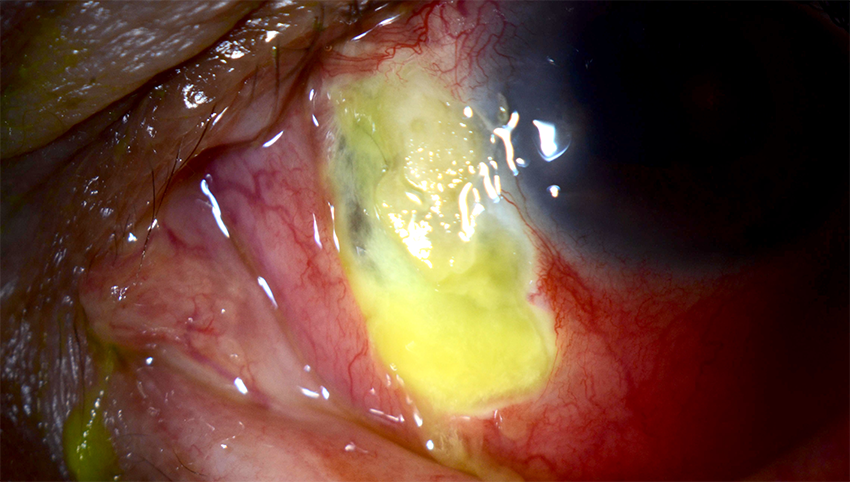Blink
Can You Guess January's Mystery Condition?
Download PDF
Make your diagnosis in the comments, and look for the answer in next month’s Blink.

Last Month’s Blink
Acute Posterior Multifocal Placoid Pigment Epitheliopathy
Written by Travis S. Dowdle, BS, at Texas Tech University Health Sciences Center School of Medicine, Lubbock, and Bryan K. Monson, MD, at Monson Vision, Logan, Utah. Photo by Bryan K. Monson, MD.
A 25-year-old man presented to the clinic with a history of five days of bilateral increasingly blurred and diminished vision and floaters. He stated that approximately one month earlier he had had a serious virus that caused moderate diarrhea and that the illness spread through his family. His visual acuity (VA) was counting fingers at five feet in the right eye, 20/250 in the left, and 20/200 bilaterally.
He had multiple cream-colored chorioretinal plaque lesions throughout the posterior pole bilaterally on slit-lamp microscopy (Figs. 1, 2). During OCT imaging, subneurosensory retinal fluid was discovered bilaterally at the macula (Figs. 3, 4), and a fluorescein angiogram showed early blockage with late hyperfluorescence. After consulting with vitreoretinal and uveitis specialists, we put the patient on a 60-mg daily oral prednisolone taper regimen for six weeks. Because these signs and symptoms can be associated with cerebral vasculitis, the patient had an MRI. However, the neurological evaluation came back negative. The patient’s vision improved significantly over the six-week period, and his VA was 20/25 in both eyes during follow-up.
This patient was diagnosed with acute posterior multifocal placoid pigment epitheliopathy (APMPPE), an inflammatory condition of the retinal pigment epithelium. Most of these patients see resolution of their symptoms without treatment, but approximately 20% can have persisting symptoms and a VA of 20/40 or worse after six months.
Read your colleagues’ discussion.
| BLINK SUBMISSIONS: Send us your ophthalmic image and its explanation in 150-250 words. E-mail to eyenet@aao.org, fax to 415-561-8575, or mail to EyeNet Magazine, 655 Beach Street, San Francisco, CA 94109. Please note that EyeNet reserves the right to edit Blink submissions. |